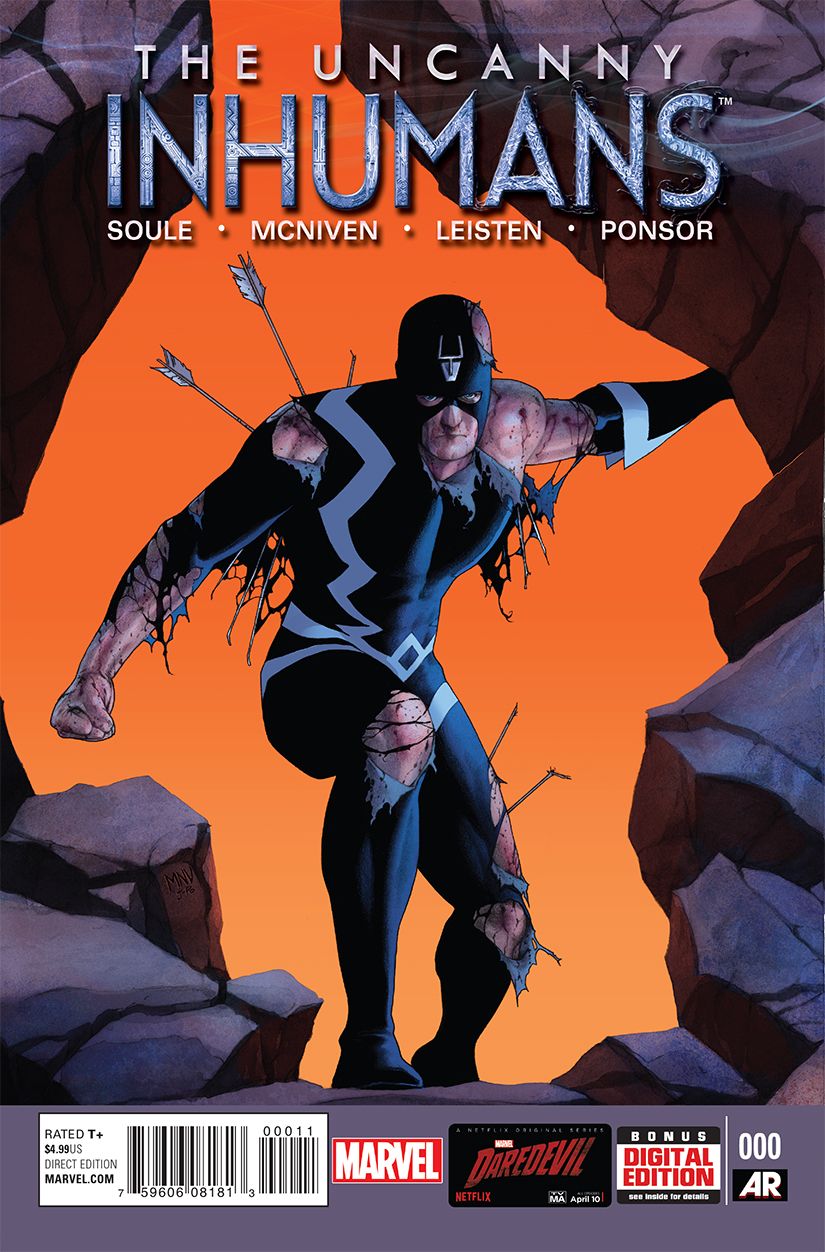If you would have told me that I'd come out of "Uncanny Inhumans" #0 as a Black Bolt fan, I would have called your April Fool's Day bluff and gone about my business. So imagine my surprise that, having closed the cover to this comic, I am able to declare myself a fan of Blackagar Boltagon thanks to writer Charles Soule and artist Steve McNiven.
Soule has masterminded the aftermath of Attilan's destruction, the Terrigen bomb's release and the subsequent establishment of New Attilan. Right now, the Inhumans are his flock to mind, and "Uncanny Inhumans" #0 provides a quick head count, a personal struggle and the threat of the destruction of everything. Like the shift in title, the writer also shifts focus from Medusa to Black Bolt. The Inhuman queen still has a strong presence, but "End Times" is clearly a Black Bolt adventure. Taking a mostly mute character and make him engaging can't be an easy assignment for a writer, but Soule does that here.
Of course, he gets a lot of help from Steve McNiven's incredibly detailed drawings. Inked by Jay Leisten, McNiven's line maintains its grit, but Leisten also preserves the integrity of McNiven's detail work and crosshatching, which is so fine as to appear driven from etching or even intaglio. McNiven also keeps the focus on Black Bolt, as Soule's tale dictates, but the once (and future?) king of the Inhumans visually dominates every panel he appears in -- until Kang arrives. Soule has made no secret of the time-travelling overlord's pending appearance in this issue but, when he first appears, that single image from McNiven, Leisten and Justin Ponsor serves up the proverbial thousand words towards pitching a Kang the Conqueror tale.
Ponsor's coloring is spot on throughout the issue, with dynamic effects ranging from amplitudes of Kirby crackle that sizzle and burst throughout Black Bolt's energy blasts to the luminous projection of the timestream in Kang's great hall. Ponsor's take on the Terrigen cloud is more ethereal and misty than I've seen elsewhere, and the whole book comes together nicely, save for one page. The lighting choices -- and resultant color effects -- on the final page make Medusa appear as though she is paying homage to DC Comics' Starfire. I'm not sure why the orange skin tone is so prevalent there, especially with a light blue source nearby, but that is truly the only string of images I find fault in within the pages of this issue.
Black Bolt is not messing around in his quest, and the choice made as to how to depict Black Bolt's first word of dialogue in this issue is stunning. Everyone's work is present here: Soule, McNiven, Leisten, Ponsor and, especially, letterer Clayton Cowles. I'm hard-pressed to recall ever seeing Black Bolt's power unleashed this way, but that single, iconic image is certain to serve as inspiration for stories to come.
Ryan Stegman, Soule's regular artistic contributor on all things Inhuman, tests his hand as a writer in a five-page back-up tale featuring NuHumans Iso and Flint. It's a quaint little tale with a convenient menace that gives the pair of NuHumans someone to fight without too much backstory or complication. I'm certain their foe will have further impact in the future but, to close out a dramatic issue like this, it seems like a nice fit to help remind readers of New Attilan. Ryan Lee's art and James Campbell's colors play along nicely with Stegman's breezy tale, which doesn't make as compelling a read as the lead story, but the choices made here are not without consequence.
The issue ends with a two-page spread from Brandon Peterson that has "Things to Come" branded across the top. I'm not going to spoil the components of the image, but the fact that it exists at the back of "Uncanny Inhumans" #0 is sure to elicit the same feelings readers had when Geoff Johns used to provide for DC, where the final page had four or five vertical strips to tease out the future. This image has ten figures that may or may not be interconnected beyond their shared fate in this title. "Uncanny Inhumans" #0 gives readers a lot to like, from Soule's writing to McNiven's art to the apparent reassertion of Black Bolt as a leader of some magnitude. This is a strong first offering and one that readers would be smart to latch onto.

